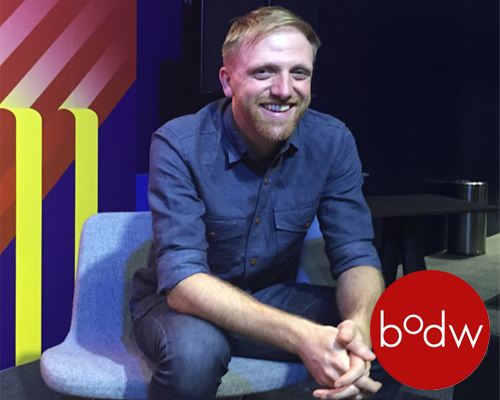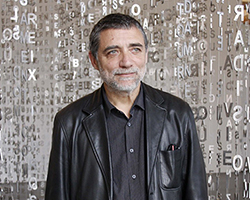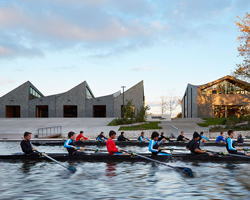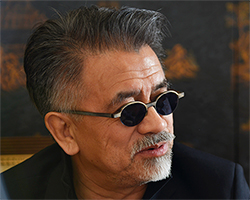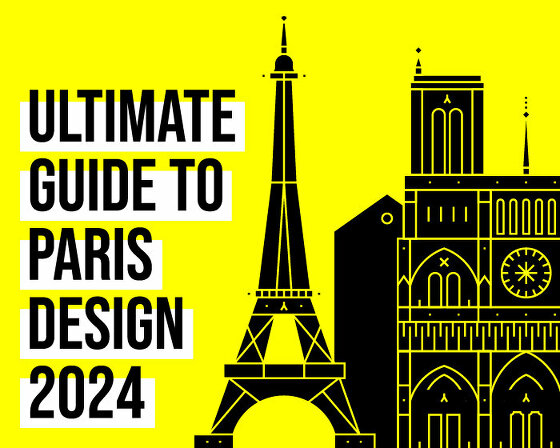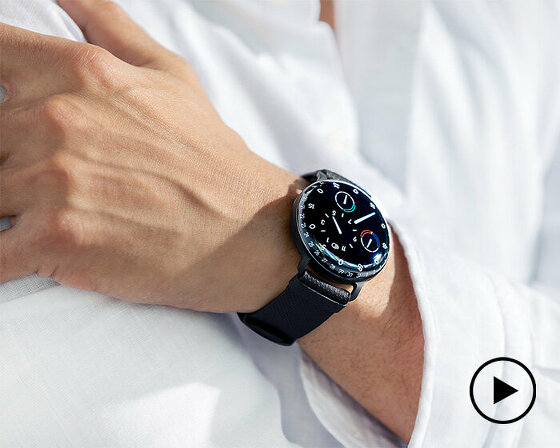entrepreneur or activist? interview with charles adler, co-founder of kickstarter
image © designboom
charles adler is a social entrepreneur, co-founder and former head of design of the groundbreaking crowd-funding website, kickstarter. as a radical creative business leader, adler’s work is diverse ranging from software systems development to interaction and communication design, interface fabrication to information architecture. designboom met charles adler in hong kong at the annual business of design week (BODW) conference where he was a speaker, to discuss his professional background, his views on the social and cultural values of kickstarter and what we can expect from him next.
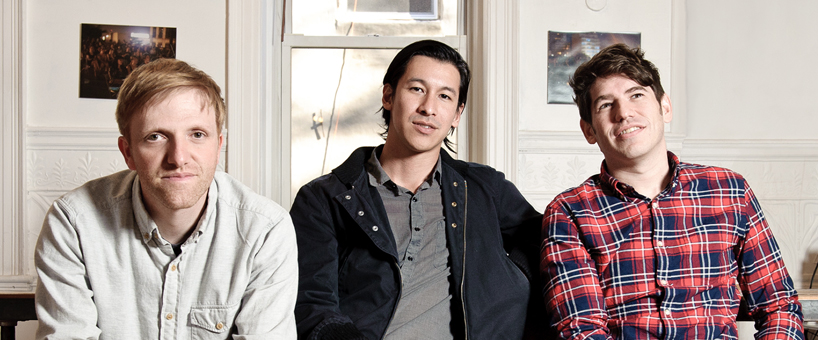
the co-founders of kickstarter (L-R): charles adler, perry chen, yancey strickler
image courtesy of kickstarter
designboom: what is kickstarter to you?
charles adler: kickstarter is about creativity, and one’s ability to have an idea and transact that idea to an object; whether it be a piece of software, or a piece of hardware, or even a garden, or a work of art, music. we are now in the age where creativity has the power to start becoming our economy, and arguably it already has. I think what’s interesting to me is this moment, where we are just at the beginning of this shift. more broadly speaking, moving beyond just creativity itself, is this idea of ‘creative independence’. whether you are an individual or a team, you now have the ability to have an idea, transact that idea, put it out into the world and get recognition for that. it creates a deeper sense of pride and power, giving us the ability to create our very own little micro economy around that product. so there’s this future that we’re going to be talking about and that everyone is effectively responsible for, we are all collectively responsible for, and have the empowerment to change.
the story of kickstarter, what I want to share, is less about how we launched and came to be, but more in terms about the attitudes behind the company — a bit about what we were seeing in the world, that we weren’t exactly pleased with, that inspired the platform itself. in talking about history, we have to recognize maybe where we’ve come from, and it’s this idea I like to talk about — the industrialization of everything!
DB: please elaborate more on this. what do you intend by industrialization of …?
CA: in this case, the industrialization of creativity in any category. right now large companies have in a way encouraged industries to start homogenizing everything — from films to houses — and this has sort of resulted in a loss of our international cultures. it’s hard to find the difference between say hong kong and chicago (where I’m from), or sydney. we start losing a bit of this individuality.
as three founders [of kickstarter] we were dismayed by this. less so because of this abstract thought about the economy and creativity, and more so about looking at friends around us. poets, writers, filmmakers, musicians, product designers. those who have brilliant ideas and cannot put those ideas out there on the market because there are these barriers in place called ‘economics’.
much of what we were trying to do was to break these barriers down, or what I like to call more elegantly ‘circumvent the barriers’ and address this issue that we kept running up against, day-in and day-out within this particular barrier, the gatekeeper — the gatekeeper being manufacturing.
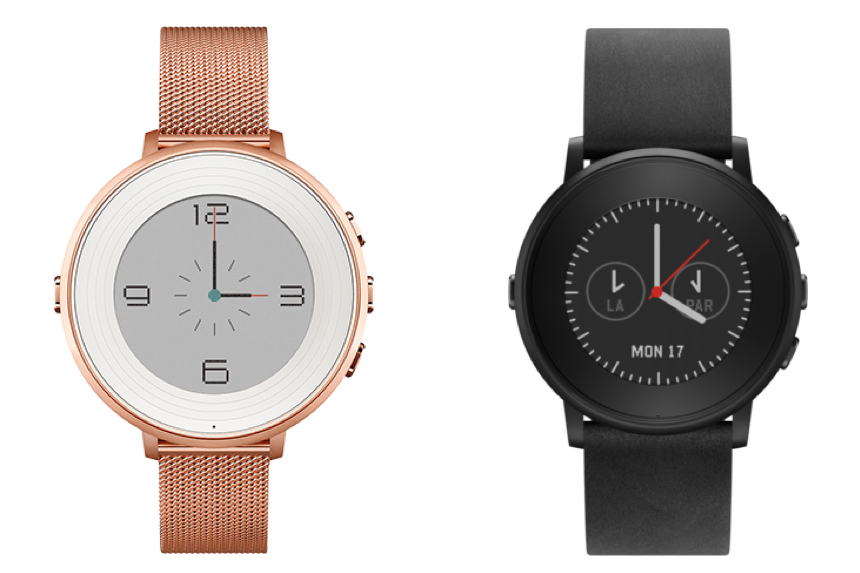
the pebble smartwatch that raised more than $10 million USD
see more about the pebble smartwatch on designboom during its kickstarter campaign and recent updates
DB: how did you manage to create a transaction or an engagement between an individual who has an idea to put out in the world, and a person or a community?
CA: ultimately we became this, the kickstarter you all know and love. really it’s the attitudes empowering individuals to put their ideas out in the world. to envision a future that is far more democratic, far more inspiring, by enabling those individuals to aspire to some greatness in a more vibrant community. permit me to go through some really quick examples. here are three differently styled projects that run a gambit of different narratives. each of these stories, involves a barrier that had to be overcome:
– the pebble watch (well, actually they beat the apple watch to market).
this was a team of five guys in california, who had this idea to bring a connected watch to the market. here, one of the obstacles is scale. for perspective – they originally only wanted to raise $100,000, but ended up raising $10 million USD. what’s interesting here is that it’s all about a community of people interested in an idea, and interested in their expression of that idea. I would argue that this exact equation is the interesting aspect in this moment.
– the next story is a much different scale. cards against humanity.
cards against humanity was the birth child of a bunch of high school friends. they developed this game over the holidays when they all came back from university, and got together in this a way to entertain each other. the cards have a sense of humor, and over the years, they invited more friends over to play this game who would enjoy themselves. so to see if this was a good idea, they posted it on kickstarter to understand if there was an even bigger audience. what’s interesting to me here, is the long scale. the crowdfunding campaign was about humble beginnings. some would argue $15,000 USD as a humble beginning, but they very much created their own economy. they are the hottest thing selling on amazon right now and have been for quite a while. this guys created all this with just a simple idea.
– the last one, is very precious to me. this was an early project on kickstarter by a mix of high school students, and middle school students, who had an idea to build a real flight simulator. each individual in the group handled different tasks — from the user interface, to the physical engineering, to reconfiguring the actual cockpit from some old rusted plane; as well as the gyroscopic movements that surrounded the infrastructure, which was the electronics and technology embedded within. what’s interesting to me about this project is less so about the technological challenges these guys had, but where they will go / be in five, ten, twenty years time. because, the thing that is encouraging here is the idea of encouragement in itself. they didn’t ask for permission from somebody who sat in an ivory tower. they went directly to their fans, friends, family and the internet at large, and then roughly raised $12,000 USD to produce the project. now their hearts have been embedded with this confidence. they can accomplish anything with a sense of economics and figuring out how much it would cost to produce this thing. their future is what excites me.
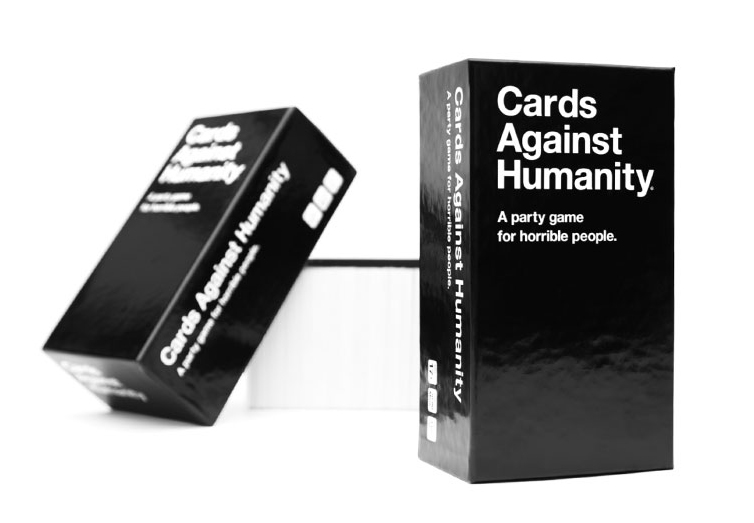
cards against humanity started out as a way for a group of friends to entertain themselves
DB: when somebody receives $100,000, how do they spend their money? do you feel responsible for governing them in that process?
CA: how does one feel when they raise $10 million USD when they only want 100? shocked. I think they get excited, with a lot of mixed emotions. I would say there is a panic at times. I think it ultimately comes down to the ‘now what?’. and with the ‘now what?’ — especially for a project like a piece of hardware — if you go into a campaign that’s planning for $100,000 USD the dream would be over. but when your plan gets multiples over that, it gets thrown out the window. something like manufacturing costs, because originally planned factories can’t handle the demand and scale. now you’ve got orders from all around the world, maybe greater than you expected. the moment is a set of mixed emotions. from kickstarter’s standpoint, I think it’s a slippery slope of responsibilities, but with those actions lead to tribulations.
DB: the web, which is mainly free distribution of content, thanks to people like you, is negotiating the power of individuals and might be able to change the manufacturing process?
CA: I’m focusing in on the ‘I’ in IOT. the internet is disrupting countries constantly. designboom (he laughs – what I find interesting and particularly why I love you guys is because you empower the individual), airbnb and UBER are all good examples of companies challenging governments and the incumbents (the taxi driver or the hotel). these challenges to the status quo are going to be very tense. it’s those conversations and the results of those conversations that move us forward.
DB: kickstarter is hugely successful and every day new projects appear. designboom receives many emails from designers saying ‘we’re on kickstarter’, please help us to get seen (they ask us to publish an article). how do you manage the problem of visibility?
CA: the visibility problem is not something that we control. so what I mean by that is that the narrative has always been that, you basically said it, that individuals run the campaign, and they reach out to you. that has always been our narrative, which is: you the creator is always responsible for your own project’s success. we do a few things like: the homepage – we feature projects on the homepage; there’s the newsletter – we send out three projects at a time, once a week. those are less about providing visibility for certain projects, and more about creating a narrative of what kickstarter is. it’s a playful competition.
what I find interesting is that you guys recognize the fluidity of business models. which is to say that you go from engaging to becoming, if you will, a cultural translator. I think ultimately what it comes down to is being excited about what you’re working on, and sharing that and finding others who are interested in it. I think the discovery thing is you guys are effectively curators. you search for projects that you think would resonate with the community you are publishing to, or simply what you want designboom to reflect. I find that interesting as well.
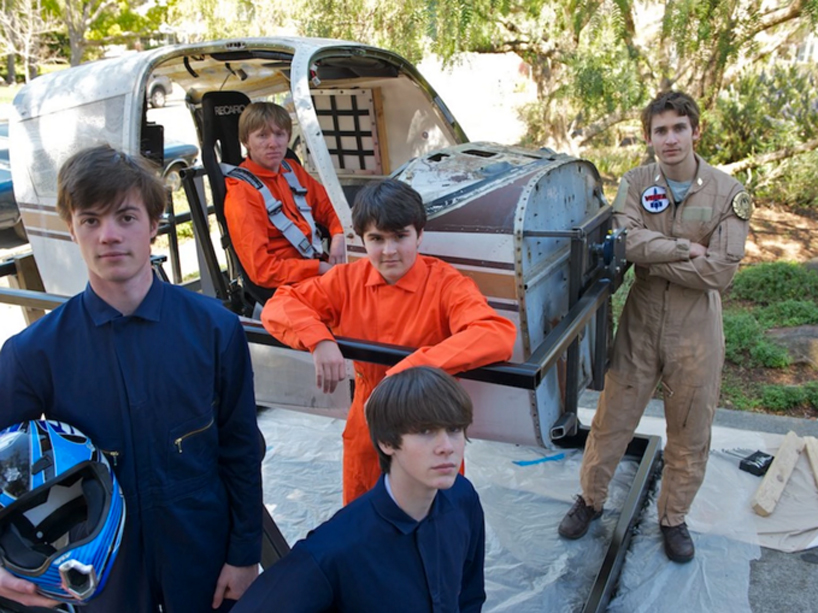
high school kids built a flight simulator from a recycled piper cub fuselage thanks to funding on kickstarter
DB: what is your professional background?
CA: as a kid, I wanted to be an architect. my father convinced me not to be an architect. I joke that about 15 years later I became an architect, what’s called an ‘information architect’. an architect for digital websites and products and I ended up going to school for mechanical engineering — the offline component is mechanical engineering. I dropped out of school back in the mid-90s around the dawn of the web, and was tinkering around at night on the web. it was very much a play thing. nobody was really doing anything of substance at that point. there were some start-ups obviously, and stuff, but I was sort of fascinated by that and became a designer / programmer. eventually, I became more of an information architect, and that’s a lot of what I ended up doing at kickstarter as head of design, basically for product design, visual design, brand identity, and all that kind of stuff; as well as managing the engineers in the early days. so, I guess by professional background in a way is a potpourri of stuff. I’m a generalist, and I play with code and design – reasonable at both of them, not great at either of them. I’m fascinated by the intersection between disciplines maybe arrogantly because I play at the intersection of disciplines; and even though I’m not great at either of them, I see the value between them. so… that’s just my ego talking.
DB: do you consider yourself more of a business man, than an activist?
CA: whoa, that’s interesting. I haven’t really thought of myself as an activist, but you’re thinking kickstarter as sort of a social activism right? I have a hard time with labels, and I think that kind of stems from my experience because in the classic sense I wouldn’t be called a ‘designer’. I didn’t formally study graphic design, I didn’t formally study product design, but I learned about it on my own. I like this term, the ‘accidental entrepreneur’… that as a kid I never sought out, ‘oh ya, I’m going to become a business man when I grow-up.’ I never thought that. I just knew I wanted to make things. I wasn’t sure quite what. I think as a kid I was fascinated by architecture as a space that people occupy, and how people occupy that space which is very akin to product design. and, I think even from an entrepreneurial perspective that’s important. how do these companies we create exist in the world and improve the world, as well as provide us with economic stability? I like making money, just like everybody else should like making money. you don’t get short answers with me, sorry! (laughs)
so, yes to both of those – entrepreneur and activist. I have this attitude where rules are meant to be broken. as defiant young people, we should redefine our acts and fight against the structures of the past. as I get older and reach my 40s, I’m getting more soft, and this shift towards this attitude are more relaxed. I found out rules are only temporary. I think today, like any other time in our past, we will be more intense about our future and it’s constant changing, second by second, minute by minute. there’s something actually quite beautiful about it this. this over the board curiosity which will lead to experimentation.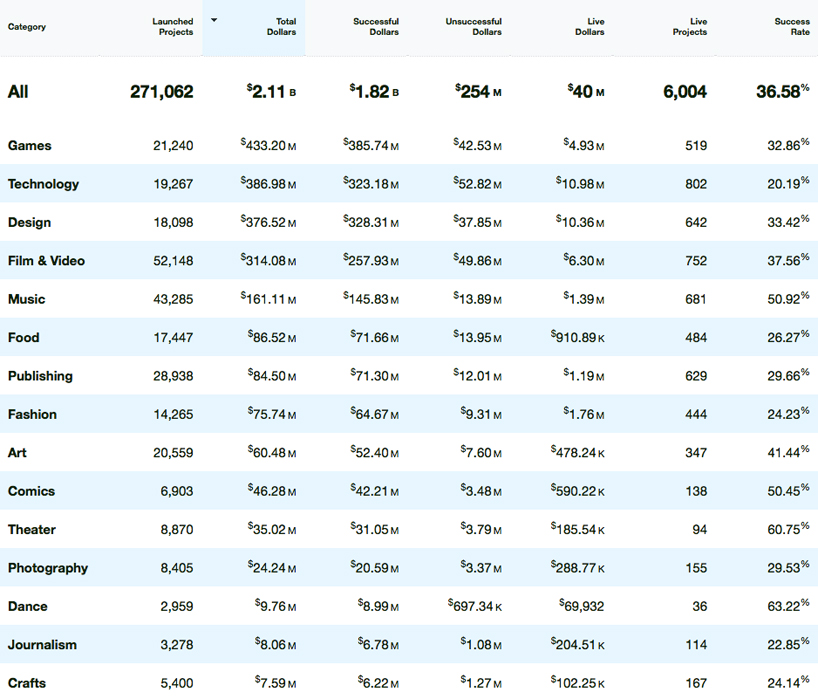
as of december 2, 2015: kickstarter’s funding success rates, amounts pledged, and the performance of successfully and unsuccessfully funded projects. statistics are available for the site overall as well as each of the 15 project categories here.
DB: what’s next, you left the company?
CA: I left because I was turning 40, and I sort of asked myself as the clock continued to tick, and the heart maybe began to beat a little bit slower, what more can I do before I’m gone? and there are a number of projects that I’ve been thinking about over the last two years that I have sort of been tinkering with and testing out so…
DB: can you share them?
CA: someday. it’s a whole other dialogue. my interest in it I think comes out of empowering creatives, individuals in small groups, and I’m even just interested in the dialogue between independent ideas and corporations and how they can sort of play equitably in the same box. meaning, dissolve the power structure… and so one of the projects is very much akin to that and it’s actually not digital at all.
DB: you’re going offline. why?
CA: um, no real reason. I think I would say that it kind of goes back to connectedness and privacy and all this kind of stuff. I think we like to slap technology onto things because we can, and you know, in the comment of play, I think that’s important, but when it comes to putting something out on mass, it becomes a different conversation. so, for me I don’t feel that we need to slap technology on everything… and what I care about more abstractly is, getting excited about people putting their ideas out there. I get excited about seeing people transact the vision of the future they had in their head, and feel a sense of pride about their ability to make that thing. I get really excited about that little moment that you can see in someone’s eye, that ‘holy shit’! and ya, so much of this next project is associated with that, and empowering more people to kind of discover their ideas in a very playful way.
DB: when will we know more about it?
CA: ya, so we’ll launch… well I’m not going to talk too much about it, but if you do some searching, you’ll find it.
DB: so you brought some money home from kickstarter, which you will now re-invest?
CA: no. there was no… so sort a different topic about what kickstarter is, we made the announcement that… we’re not going to sell. we also paired with that… you guys are familiar with public benefit corporation, right? so we shifted our corporate structure to a public benefit corporation. there is no payday with kickstarter. instead I sort of dumped some personal money into this project back in july, and now we’re going through the interesting realm of fundraising. going through it all over again!

since 2002, the hong kong design centre has been organizing the business of design week (BODW) – asia’s leading annual event on design innovation and brands. BODW brings together some of the world’s most outstanding design masters and influential business figures to discuss and share their views on creative thinking and design management from their varied cultural and social perspectives, providing a valuable platform for individuals to network, exchange ideas and explore potential working partnerships. the 2015 edition of BODW introduces the partner city initiative, inviting barcelona as the inaugural affiliate. this sees a number of barcelona creative talents — from the fields of design, architecture, urbanism, gastronomy and sport — take to the stage to discuss the cultural capital’s community-driven design approach and rich artistic heritage.
BODW 2015 (15)
PRODUCT LIBRARY
a diverse digital database that acts as a valuable guide in gaining insight and information about a product directly from the manufacturer, and serves as a rich reference point in developing a project or scheme.
